Menus
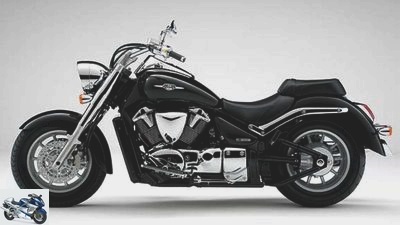
Suzuki
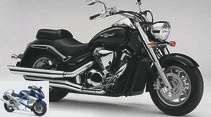
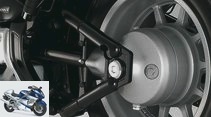
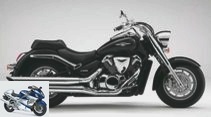
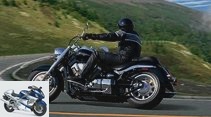
8th photos

Suzuki
1/8
Suzuki Intruder C 1800 R
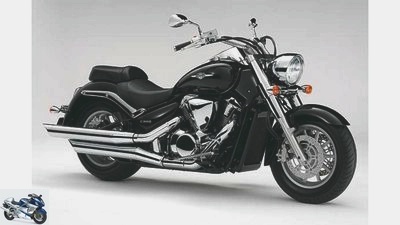
Suzuki
2/8
Suzuki Intruder C 1800 R
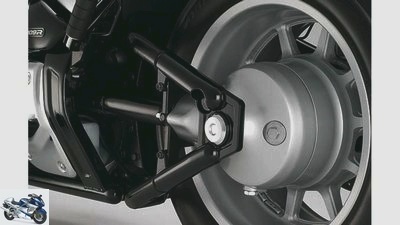
Suzuki
3/8
Suzuki Intruder C 1800 R

Suzuki
4/8
Suzuki Intruder C 1800 R
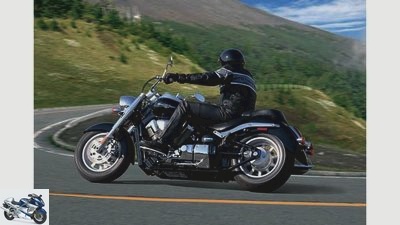
Suzuki
5/8
Suzuki Intruder C 1800 R
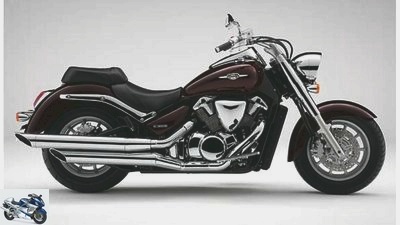
Suzuki
6/8
Suzuki Intruder C 1800 R
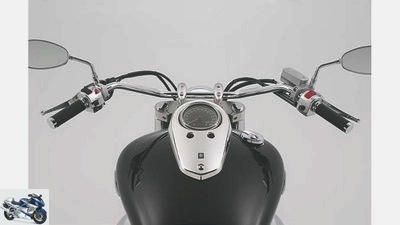
Suzuki
7/8
Suzuki Intruder C 1800 R
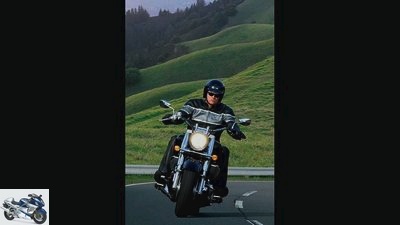
Suzuki
8/8
Suzuki Intruder C 1800 R
Test Suzuki C 1800 R
The big C
Suzuki is now building the really large, classic cruiser, the C 1800 R, around the elemental engine of the M 1800 R..
Friends of large-volume, classic-looking cruisers have been poorly served at Suzuki in recent years. The 125 hp M 1800 R power cruiser was the only answer to the competition. Outwardly and in terms of driving experience, however, he was as far removed from a down-to-earth cruiser as the rock brat Avril Lavigne from country singer Johnny Cash musically.
Now Suzuki is closing the gap with the new C 1800 R. However, the sheer, explosive power of the modern four-valve V-engine was slightly reduced. Instead of 125 it is nominally ?? only ?? 113 HP and the gigantic torque was also reduced from 160 to ?? just ?? 155 Nm reduced. In the fourth of five gears, the dynamometer attested 107 hp, plus a maximum torque of 143 Nm. And like Triumph with the Rocket III, Suzuki also limits the torque of its Big Twin in the lower gears (see performance diagram) in order to nip cockiness in the bud.
But no reason to be sad. The C 1800 R has plenty of power and torque. Better still: Your throttle response is nowhere near as rough as in the M variant. She goes on the gas softer, more controllable, more carefree. This is a wonderful way to cruise, especially since the gearbox and final drive also go about their work unobtrusively. But if you want to know, just open the tap. Stomping and shaking at low speeds, the Big Twin makes forwards. Whether in third, fourth or fifth gear? From 50 km / h to well over 200 km / h, the engine pushes forwards with a hammer without pause, as if it wanted to plow the asphalt.
Intoxicating but exhausting. Because beyond 160 km / h, the driver hangs on the protruding handlebars pulled far back like a flag in the wind. And the spongy, soft, comfort-trimmed chassis does not really want to feel at high speed. Slowing down is less stressful, even if the 384 kilogram cruiser needs to be tilted vigorously, the wide tires tend to be sensitive to ruts and draw attention to themselves on bad roads with proper self-steering behavior. The combination brake works very pleasantly and can easily be dosed, easily handling the heavy weight of the cruiser. Its stoppers have nothing in common with the snappy radial brake calipers of the M model. Unfortunately, his wish for an ABS remains unfulfilled.
Technical specifications
engine
Water-cooled two-cylinder four-stroke 54-degree V-engine, two overhead, chain-driven camshafts, four valves per cylinder, bucket tappets, injection, Ø 52 mm, regulated catalytic converter with secondary air system, 460 W alternator, 12 V / 18 Ah battery, Mechanically operated multi-plate oil bath clutch, five-speed gearbox, cardan shaft, secondary ratio 2.82.
Bore x stroke 112.0 x 90.5 mm
Cubic capacity 1783 cm3
Compression ratio 10.5: 1
Rated output 83.0 kW (113 hp) at 6000 rpm
Max. Torque 115 Nm at 3500 rpm
landing gear
Double loop frame made of steel, upside-down fork, Ø 46 mm, two-arm swing arm made of aluminum, central spring strut with lever system, adjustable spring base, double disc brake at the front, Ø 290 mm, six-piston fixed caliper, disc brake at the rear, Ø 275 mm, double-piston floating caliper
Cast aluminum wheels 3.50 x 16; 8.00 x 16
Tires 150/80 R 16; 240/55 R 16
Tires tested: Bridgestone Exedra G853 "E.", 852 "G"
Dimensions + weights
Wheelbase 1755 mm, steering head angle 58.0 degrees, caster 130 mm, suspension travel f / r 130/118 mm, weight with a full tank * 384 kg, payload * 216 kg, tank capacity 19.0 liters.
Guarantee: two years
Service intervals: every 6000 km
Colors: black, red, white / silver
Price: 13490 euros
Additional costs: 210 euros
Readings
Performance
Top speed 1210 km / h
acceleration
0-100 km / h 4.4 sec
0-140 km / h 7.9 sec
0 200 km / h 21.4 sec
Draft
60 100 km / h 5.3 sec
100 140 km / h 6.0 sec
140 180 km / h 8.5 sec
Speedometer deviation
Effective (display 50/100) 47/95 km / h
consumption
Country road 5.6 l / 100 km / h
Theor. Range of the country road 339 km
Fuel type: Super
* MOTORCYCLE measurements; 1 Manufacturer information; Diagram: power on the crankshaft; Measurements on Dynojet chassis dynamometer 150, corrected according to 95/1 / EG, maximum possible deviation ± 5%
Noticed
+ plus
+ Plenty of torque and plenty of power
+ Chassis comfortable and soft
+ Combination brake easy to dose and effective
+ Transmission inconspicuous and precise
+ Sitting position casual and comfortable
– minus
– Wide tires make it sensitive to ruts
– Steering precision could be better
– Consumption a bit high
– ABS not available
Related articles
-
Comparison test muscle bikes Ducati Harley-Davidson Suzuki Yamaha
Gargolov 24 pictures Gargolov 1/24 The four muscle animals. Gargolov 2/24 Yamaha Vmax – Yes, that fits. The surge of combustion of the 200PS has to go through four …
-
Bilski top test Suzuki SV 1000 What do you want curve robbers, backpack tourists or after-work cruisers? all of them have a lot of fun with Suzuki …
-
Jahn comparison test Powercruiser Kawasaki VN 2000, Suzuki Intruder M 1800 R, Yamaha XV 1900 Midnight Star Punchtime Nobody distributes more displacement and …
-
Top test Suzuki SV 650 And the beat goes on Suzuki completely renovated its successful SV 650 model. The most important change: The lively twin received …
-
Euro 3 classic: Suzuki Intruder M 1800 R
17 pictures 1/17 Suzuki Intruder M 1800 R. 2/17 Suzuki Intruder M 1800 R ….
-
Test Suzuki VL 1500 Intruder LC
Test Suzuki VL 1500 Intruder LC rally The VL 1500 Intruder dispels any doubts: From now on, cruising is a top priority at Suzuki. Full …
-
Suzuki GSX-R 750 – GSX-R 1000 in comparison test
Rivas Family duel: Suzuki GSX-R 750 / GSX-R 1000 The super athletes from Suzuki in comparison test The GSX-R sisters are visually difficult to…
-
Suzuki Gladius and Kawasaki ER-6n in comparison test
Blacksmith 16 photos Jahn 1/16 Suzuki Gladius and Kawasaki ER-6n in comparison test. Which of the 650 twin-cylinder has the edge in the end? Jahn 2/16…
-
Test: Honda CBF 1000 F against Suzuki GSX 1250 FA
Test: Honda CBF 1000 F against Suzuki GSX 1250 FA Sporty Nippon tourers in a comparison test Content of Displacement and draft shield – the…
-
Johann Test Suzuki Bandit 650 ABS Bandit reissue An institution like the Suzuki Bandit 650 cannot be written off from a recently launched Yamaha XJ6….